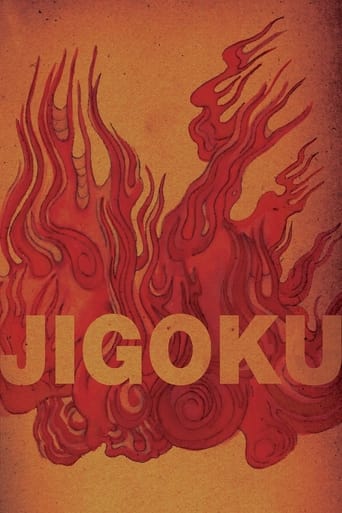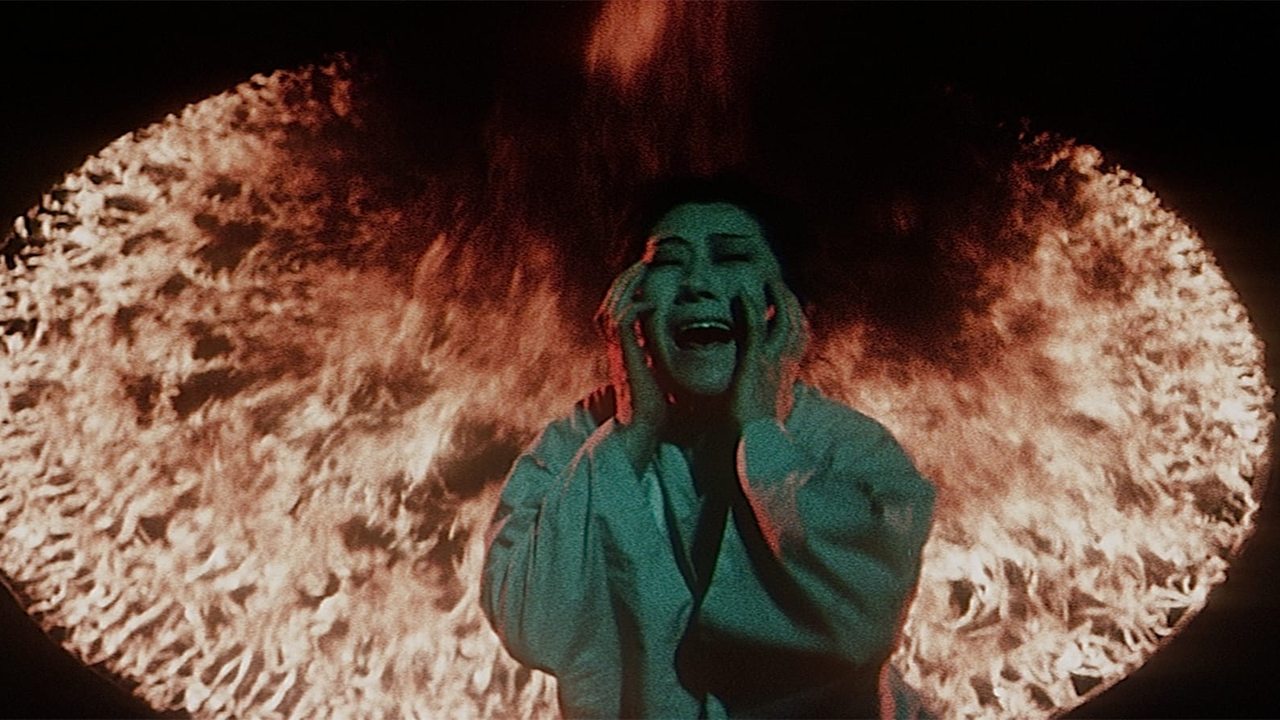gavin6942
A group of sinners involved in interconnected tales of murder, revenge, deceit and adultery all meet at the Gates of Hell.The film was not expected to be well received, as Shintoho studio was considered to be a maker of low-budget, gory films. Jigoku was made in a hurry, and was the last Shintoho production. For the scenes which take place in hell, the cast and crew used Shintoho's largest sound stage and put dirt over it. In a recent documentary, a crew member said that normally it would be just the crew helping to build the sets, but because it was Shintoho's last production, all the extras were helping.For the first half of the film, you definitely feel that the picture is low budget and somewhat exploitative. Much of the mood is set by having the rooms dimly lit. Maybe it needs a restoration, but it does look a bit rough, too. Once we switch to the afterlife portion, though, wow... we get some great effects and moods, which are ahead of their time and look like a precursor to such films as Fulci's "The Beyond".What struck me as odd, though, was the idea of "heaven" and "hell" in a Japanese film. I guess I don't know much about religion in Japan, but these seem like very western concepts. I guess I need to look into that more.
jaguiar313
Jigoku is a very strange and disturbing 1960 Japanese horror film whose title literally means "Hell". The film opens with student Shiro (Shigeru Amachi) who reluctantly falls in with another student named Tamura (Yoichi Numata), despite Shiro feeling very uncomfortable with this morally void young man. When driving together one night, Tamura runs over a drunken Yakuza and kills him. Shiro, now racked with guilt, starts to see his life spinning out of control as his fiancé' (Utako Mitsuya) is killed in a car accident and his mother takes ill. Even worse, the drunk Yakuza's mother and girlfriend seek revenge and Shiro becomes surrounded with a group of people who, like him, all have sins to hide. Are Shiro and those around him truly on a path to pay for their sins? Director Nobuo Nakagawa boldly answers this question as the final act of the film literally takes place in Hell and eternal punishment is brutally given out to Shiro and the sinful individuals that came to surround him. The film takes a surreal turn as Nobuo gives us a visually haunting portrayal of hell and the diverse punishments suffered by those who find themselves there. Shiro might have been able to avoid this fate had he gone to the authorities and confessed but, now must not only suffer himself but, watch his fiancé' and their unborn child suffer as well. The other characters are also punished according to their sins and Nobuo takes us along for their suffering unflinchingly with some very disturbing sequences, some with unexpected gore. As this is 1960, most of the visuals are done in camera with just a few composite shots thus making this film even more effective. Jigoku may not be for everyone. It is a slow paced film but, that serves the story as we experience Shiro's guilt and the lack of morality by those around him, then are taken to Hell with them to see them receive their punishment. And it is a visually stunning and very unsettling trip if you're up to it. A bold and haunting example of 60s Japanese Horror cinema. 7/10
Patryk Czekaj
Jigoku is a bizarrely sinister film, one that has become an instant classic in the horror genre. It's known around the world as the first film that used gore to such a significant degree. In all of its bloodshed glory, Jigoku is also a frightening cautionary tale, which - through its brutally vivid imagery – introduces the important religious matters, such as the afterlife and what it really means to repay one's sins in hell.Two students – the first (Tamura) is the incarnation of pure evil; the second (Shiro) is a friendly guy, who just can't get rid of his devil friend – run over a drunkard somewhere during the night. They flee the scene in a screwy fashion, leaving the man for dead. Unfortunately for them, it so happens that the dead man was a yakuza, and his mom was very close when the incident occurred, and she was able to remember the car's license plate numbers. Shiro tries to lead a peaceful life with his loving girlfriend, but is ultimately unable to due to a strange and horrible turn of events. First of all, only a day after the accident his girl is killed as the taxi they both were in crashes into a lamppost. Secondly, the old lady bound for revenge – along with the dead yakuza's grieving girlfriend Kiyochi – track the two students down.Shiro receives a letter, which informs him about his mother's poor state, and so he decides to travel to the retirement house in order to spend some time with her. Tamura is following his every move like a ghost, like a devil who doesn't let go and curses you with his presence. His evil aura drags everyone around into a state of deep existential angst. When in the retirement community, Shiro falls in love with a girl who is strangely similar to his late girlfriend. After the death of his mother and a huge wrangle caused by the discovery of a few unexpected love affairs (Shiro's father for one), the revengeful old lady and her accomplice arrive at the scene. From this point on, things get odder with every following minute. Kiyochi falls of a bridge after she attempts to kill Shiro. A few moments later, Tamura is shot dead in the exact same place, and lands lifelessly few hundred meters below. The final sequence of the first act takes places during one of the evening feasts. The dinner turns into a disquieting bloodbath so to say, when all of the guest and strangers die one after another, some of them poisoned, other strangled.Now it's time for act two, the one where all things gory start to happen. All of the sinners the audience has seen before are now in hell. And it looks exactly how people picture it. It's a dark and horrifying place, full of burning fire, with huge, bowls where people are being boiled, and with angels of death all around announcing punishments and tortures. Shiro is trying to reunite with his love and their unborn baby, and – in the meantime – every other character gets his or her comeuppance. In the most grizzly and violent manner people are sliced, mutilated, and so on. Finally they realize how harsh a punishment for a sin can really be.Watching Jigoku proves to be a disturbing experience to say the least, but its religious values are irrefutable. Blood and gore serves its purpose when all those sick-and-twisted people, whose sins were previously exposed, are united in pain and anguish, unable to change their lamentable fate. Even though Jigoku might seem too bizarre and ludicrous for some viewers, it's a highly recommended view for all the horror fans and Japan lovers alike.
ebossert
Have you ever watched a film so horrible that you simply could not reconcile its atrociousness with its glowing IMDb rating? I had this experience after watching Jigoku earlier today. The IMDb reviews were raving harder than a teenager after midnight – with terms like "masterpiece" being thrown around, apparently on a whim. I was expecting this film to be pretty good. Nothing prepared me for the absolute disaster I was about to see.Where to begin? Let's start with the single worst aspect of Jigoku – the acting. I'm not exaggerating when I say that the acting consists of some of the most systematically awful performances I've seen in any movie . . . ever. A typical bad film will have various moments of deficient acting, but Jigoku is systematically deficient, meaning that there are extremely long periods of time where just about everyone on screen is stinking the place out. For example, the latter half of the film – which takes place in Japanese Hell – is basically a 45-minute trainwreck that is the epitome of quintessential artificiality. The centerpiece of which is perhaps the scene with the lead character falling awkwardly after someone disappears near the river. But there are so many badly-acted moments that it would require booklength treatment to cover it all. However, the viewer should look forward to the food poisoning scene, which makes a Sci-Fi Channel Original Film look Oscar worthy.What else is wrong with Jigoku? Everything – storyline, character development, etc. – can be summarily described as unintentionally hilarious.Cheap, ineffective scares and downright stupid deaths are used. One such scene occurs midway thru when two people trip on a rope bridge. The movie then cuts to their stunt-dummies falling onto some hard rocks below. It was probably meant to be horrifying, but it came off as exceedingly funny. The character who runs over the Yakuza drunk was so damn slow in applying the brakes that it was reminiscent of Austin Powers when the steamroller was slowly approaching the screaming baddie from fifty yards away. The subsequent death of the girl in another car accident was also stupifying, especially considering how her boyfriend was sitting right next to her yet suffered no injuries whatsoever. Perhaps the funniest series of deaths take place during the punishment of random dudes in hell. Just look for the dude who gets "flayed", which will undoubtedly have the viewer rolling hysterically.At one point the movie shows extreme closeups of random people screaming at the camera, which gets very annoying.The finale has the lead character run in ultra cheesy fashion (in slow-motion) after his baby, which is strapped onto a big, turning wheel. I saw the baby on the wheel the first time, but the filmmakers inexplicably found it necessary to repeat the same exact scene over a dozen times. Imagine a 3-second scene being repeated over and over and over again every few seconds. It's almost as if the filmmakers weren't so much intending on depicting hell as they were attempting to INFLICT hell on the viewer with this pathetic attempt at film-making.To supplement the horrible finale with the spinning baby, the lead character jumps in an attempt to save the child, but mis-times it so badly that he ends up on the OPPOSITE SIDE of the giant wheel. I knew this guy was stupid, but it doesn't get any more moronic than that.Some gore (that was a ahead of its time) and a few scenes with fantastic imagery could have saved this one from the cinema sewer, but everything else is of such an unbelievably low quality that this film easily steamrolls to the bottom of the barrel.


 AD
AD



